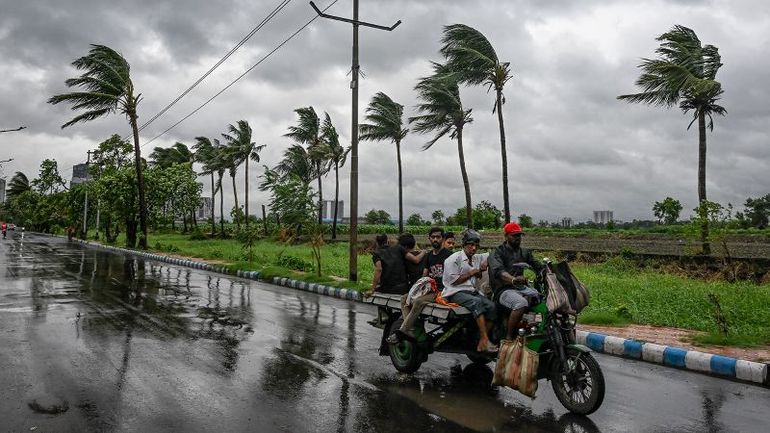
Cyclone Remal Causes Massive Evacuation in Bangladesh and India

Tropical Cyclone Remal struck Bangladesh, triggering widespread evacuations and heavy rainfall, while moving into eastern India with destructive winds and flooding. The cyclone's impact includes uprooted trees, flooded roads, and significant damage across the region.
Tropical Cyclone Remal hit Bangladesh on Sunday, bringing heavy rain and strong winds. The storm is now moving towards eastern India, causing trees to fall, roads to flood, and widespread damage.
Authorities evacuated over 1 million people from their homes in both countries before the cyclone arrived. Volunteers and army personnel are working together to help with the cleanup and provide food and water to those who have been displaced.
Remal has made landfall with wind gusts reaching up to 135 kilometers per hour (84 mph), according to the Indian Meteorological Department. The storm is currently moving northwards along the coasts of Bangladesh and West Bengal.
After hitting the coast, Remal weakened with wind speeds dropping to 115 kilometers per hour (71 mph). CNN Weather forecasts that the storm will bring heavy rainfall of more than 89mm (3.5 inches) and wind-driven storm surges of 2.5 to 3.7 meters to the Bay of Bengal coasts.
Cyclone Remal made landfall in Bangladesh on May 26, 2024.
Cyclone Remal made landfall in Bangladesh on May 26, 2024.
The Bangladesh Meteorological Department has raised the Great Danger Signal 10 at the maritime ports of Mongla and Payra on Sunday. All fishing and boating vessels are advised to stay in shelter.
About 2 million individuals reside in regions of Bangladesh that are impacted by storms, as reported by the non-profit organization BRAC.
Dr. Md Liakath Ali, a disaster specialist at BRAC, stated that at least 500,000 of these individuals dwell in homes constructed from materials like clay, wood, plastic sheets, straw, or tin.
Ali reported that millions of people are currently experiencing power outages due to authorities proactively shutting down electricity in various areas to prevent accidents. The disruption in supply is a result of fallen trees and damaged power lines.
One particularly at-risk group is the stateless Rohingya communities who sought refuge in Cox's Bazar after fleeing persecution in Myanmar in 2017. These communities reside in the world's largest refugee camps, where the flimsy shelters are susceptible to landslides and floods. Many live in bamboo and tarpaulin shelters on hilly slopes that are prone to severe weather conditions like strong winds, rain, and landslides.
Locals stand near the sea as Cyclone Remal made landfall in Bangladesh on May 26, 2024.
Locals stand near the sea as Cyclone Remal made landfall in Bangladesh on May 26, 2024.
K M Asad/LightRocket/Getty Images
Video taken by a BRAC’s volunteer early Monday in Mongla showed a woman struggling to walk through the floodwaters as gusts of wind nearly toppled her over.
In India, workers from the National Disaster Response Force were shown in a video clearing broken trees in West Bengal while heavy rain poured down on them. The Coast Guard was also closely monitoring the landfall of Cyclone Remal, with ships and hovercraft ready to address any difficulties that may arise.
The main international airport in Kolkata, the capital of West Bengal, was closed on Sunday, causing disruptions to flights as a result.
Tropical Cyclone Remal has been churning across the Bay of Bengal since late last week prompting authorities to prepare ahead of its arrival.
People are riding on a scooter as rains hit Kolkata, India ahead of Cyclone Remal's landfall on May 26, 2024.
People are riding on a scooter as rains hit Kolkata, India ahead of Cyclone Remal's landfall on May 26, 2024.
Sudipta Das/NurPhoto/Getty Images
Indian Prime Minister Narendra Modi recently conducted a review of disaster management and preparation efforts. In a message on X, Modi expressed his prayers for everyone's safety and wellbeing.
Cyclones, also known as typhoons and hurricanes in different parts of the world, are powerful storms fueled by warm ocean water and moist air. Scientists warn that the climate crisis is intensifying these storms, making them even more dangerous.
A study published in 2021 by researchers at the Shenzhen Institute of Meteorological Innovation and the Chinese University of Hong Kong and published in Frontiers in Earth Science found that tropical cyclones in Asia could have double the destructive power by the end of the century, with scientists saying the human-made climate crisis is already making them stronger.
The cyclone comes as parts of Western and Central India continue to bake under severe heat, with temperatures soaring beyond 45 degrees Celsius (113 Fahrenheit) in some cities, causing illness and forcing some schools to close.
Climate experts have been cautioning that the extreme weather events will worsen due to the climate crisis, putting millions of people in India at risk.
Editor's P/S:
Tropical Cyclone Remal's impact on Bangladesh and India has been devastating, leaving a trail of destruction and displacement. The storm's powerful winds and heavy rainfall have caused widespread damage, uprooting trees, flooding roads, and disrupting essential services. The evacuation of over a million people before the cyclone's arrival was a crucial step in minimizing casualties, but the recovery process will be long and challenging.
The impact of climate change on the intensity and frequency of cyclones is a growing concern. Scientists have warned that the warming of the ocean due to human activities is making these storms more powerful and destructive. As the climate crisis continues, it is imperative that countries invest in disaster preparedness and resilience measures to mitigate the risks and protect vulnerable communities from the devastating impacts of cyclones.









